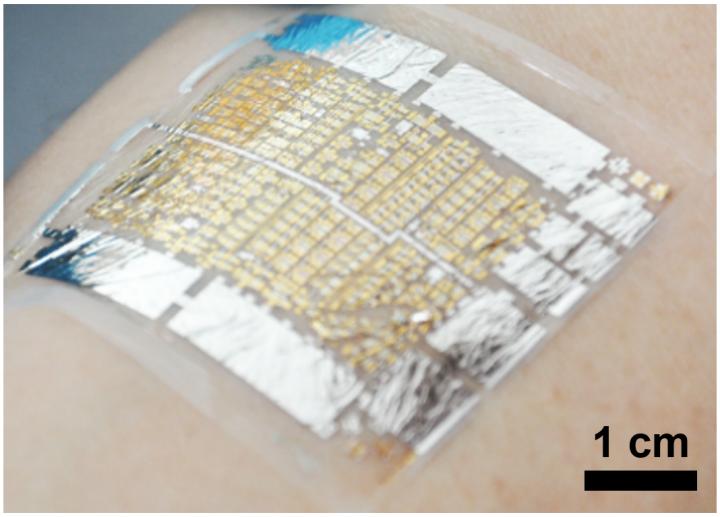Researchers at Osaka University and JOANNEUM RESEARCH develop ultrathin self-powered e-health patches that can monitor a user’s pulse and blood pressure, which may lead to new flexible motion-based energy harvesting devices

Credit: Osaka University
Osaka, Japan – Scientists at Osaka University, in cooperation with JOANNEUM RESEARCH (Weiz, Austria), introduced wireless health monitoring patches that use embedded piezoelectric nanogenerators to power themselves with harvested biomechanical energy. This work may lead to new autonomous health sensors as well as battery-less wearable electronic devices.
As wearable technology and smart sensors become increasingly popular, the problem of providing power to all of these devices become more relevant. While the energy requirements of each component may be modest, the need for wires or even batteries become burdensome and inconvenient. That is why new energy harvesting methods are needed. Also, the ability for integrated health monitors to use ambient motion to both power and activate sensors will help accelerate their adoption in doctor’s offices.
Now, an international team of researchers from Japan and Austria has invented new ultraflexible patches with a ferroelectric polymer that can not only sense a patient’s pulse and blood pressure, but also power themselves from normal movements. The key was starting with a substrate just one micron thick. Using a strong electric field, ferroelectric crystalline domains in a copolymer were aligned so that the sample had a large electric dipole moment. Based on the piezoelectric effect, which is very efficient in converting natural motion into small electric voltages, the device responds rapidly to strain or pressure changes. These voltages can be transduced either into signals for the medical sensors or to directly harvest the energy. “Our e-health patches may be employed as part of screening for lifestyle-related diseases such as heart disorders, signs of stress, and sleep apnea,” first-author Andreas Petritz says.
The authors estimate that multilayer patches can harvest up to 200 millijoules per day from biomechanical motions if placed on joints, like knees or elbows. This is enough to monitor cardiovascular parameters several times a day. And the patches are so thin that they are barely perceptible thus making a necessary evil for many patients–daily health monitoring–less unpleasant.
“We expect that our findings will assist in the development of other sheet-type sensor systems that can perform precise biomonitoring when affixed to the skin surface,” senior author Tsuyoshi Sekitani says. Additional modules allow other features, such as wireless communication with a smartphone or computer.
###
The article, “Imperceptible energy harvesting device and biomedical sensor based on ultraflexible ferroelectric transducers and organic diodes,” was published in Nature Communications at DOI: https:/
About Osaka University
Osaka University was founded in 1931 as one of the seven imperial universities of Japan and is now one of Japan’s leading comprehensive universities with a broad disciplinary spectrum. This strength is coupled with a singular drive for innovation that extends throughout the scientific process, from fundamental research to the creation of applied technology with positive economic impacts. Its commitment to innovation has been recognized in Japan and around the world, being named Japan’s most innovative university in 2015 (Reuters 2015 Top 100) and one of the most innovative institutions in the world in 2017 (Innovative Universities and the Nature Index Innovation 2017). Now, Osaka University is leveraging its role as a Designated National University Corporation selected by the Ministry of Education, Culture, Sports, Science and Technology to contribute to innovation for human welfare, sustainable development of society, and social transformation.
Website: https:/
About JOANNEUM RESEARCH
JOANNEUM RESEARCH develops solutions and technologies for a broad range of industries and public agencies and is engaged in top applied research at an international level. Optimally embedded in the national and international innovation network our staff develops innovations in the three thematic areas of information and production technologies, human technology and medicine, society and sustainability.
Using modern technologies and processes based on miniaturisation, integration and material optimisation, MATERIALS – The Institute for Surface Technologies and Photonics – offers interdisciplinary solutions for the entire value chain. These include large-area micro- and nanostructures, bio- and chemosensors, light technologies, functionalised surfaces or laser processes.
Website: http://www.
Media Contact
Tsuyoshi Sekitani
[email protected]
Related Journal Article
http://dx.




